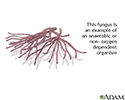Anaerobic
The word anaerobic indicates "without oxygen." The term has many uses in medicine.
Anaerobic bacteria are germs that can survive and grow where there is no oxygen. For example, it can thrive in human tissue that is injured and does not have oxygen-rich blood flowing to it. Infections like tetanus and gangrene are caused by anaerobic bacteria. Anaerobic infections typically cause abscesses (buildups of pus), and death of tissue. Many anaerobic bacteria produce enzymes that destroy tissue and, sometimes, potent toxins.
Besides bacteria, some protozoans and worms are also anaerobic.
Illnesses that create a lack of oxygen in the body can force the body into anaerobic activity. This can cause harmful chemicals to form. It can happen in all types of shock.
Anaerobic is the opposite of aerobic .
Aerobic
Aerobic means oxygen is needed to: SurviveGrowWork properlyFor example, bacteria that need oxygen to grow are called aerobic bacteria. Aerobic is the...

In exercise, our bodies need to perform both anaerobic and aerobic reactions to supply us with energy. We need aerobic reactions for slower and more prolonged exercise like walking or jogging. Anaerobic reactions are faster. We need them during shorter, more intense activities like sprinting.
Anaerobic exercise leads to a buildup of lactic acid in our tissues. We need oxygen to remove the lactic acid. When sprinters breathe heavily after running a race, they are removing the lactic acid by providing oxygen to their bodies.
References
Dorland's Online Medical Dictionary. Available at: dorlands.com/def.jsp?id=100004185. Accessed May 27, 2015.
Fort GG. Anaerobic infection. In: Ferri FF, ed. Ferri's Clinical Advisor 2015 . 1st ed. Philadelphia, PA: Elsevier Mosby; 2014:section I.
Review Date: 4/27/2015
Reviewed By: Frank A. Greco, MD, PhD, Director, Biophysical Laboratory, Edith Nourse Rogers Memorial Hospital, Bedford, MA. Review provided by VeriMed Healthcare Network. Also reviewed by David Zieve, MD, MHA, Isla Ogilvie, PhD, and the A.D.A.M. Editorial team.

